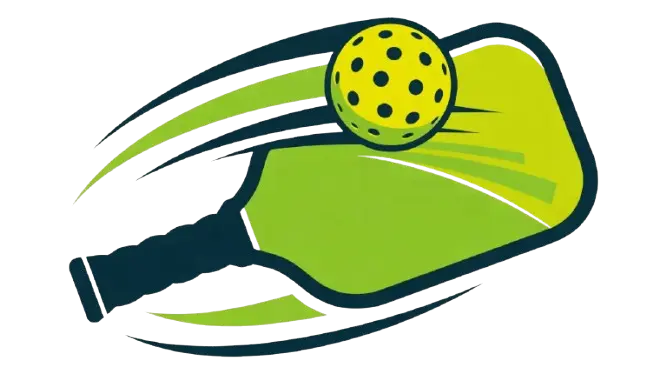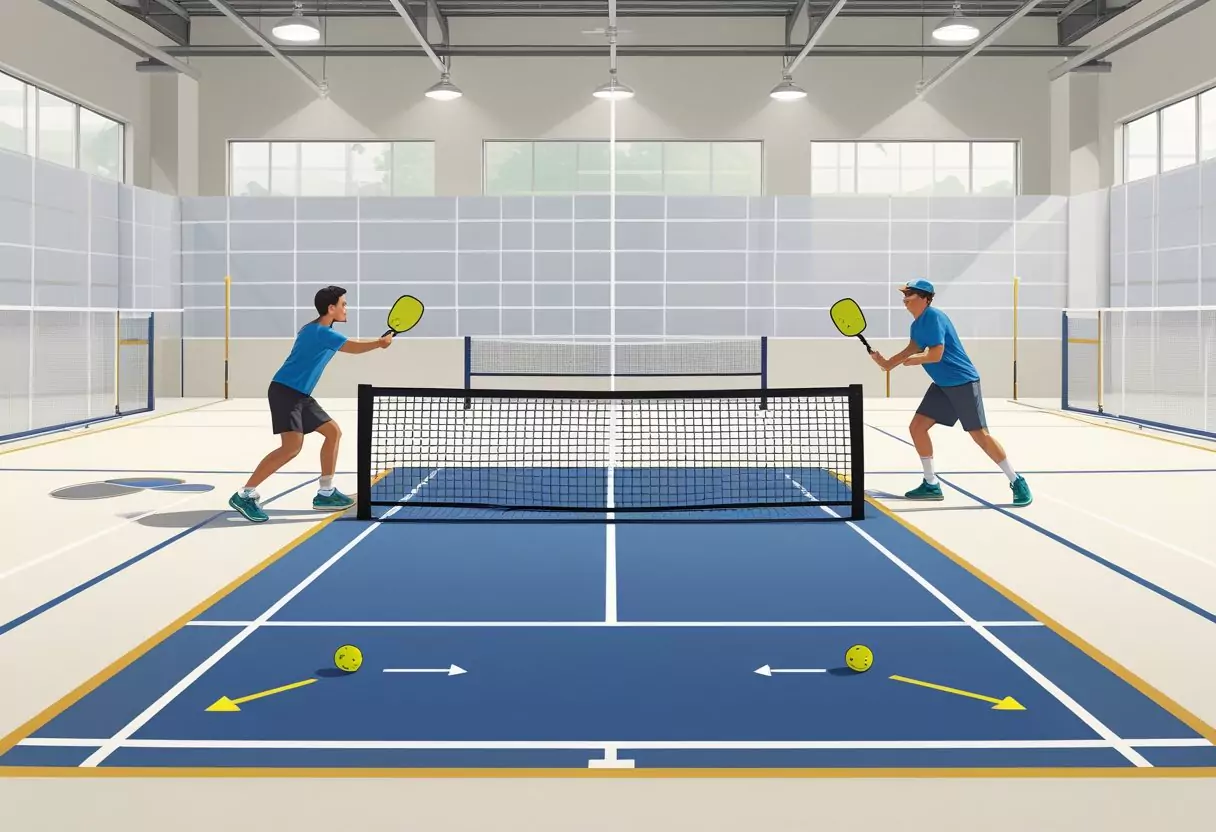Pickleball is a fast-growing sport that combines elements of tennis, badminton, and ping pong. To play well and fairly, understanding the rules is essential. The core rules include how to serve, score points, follow court boundaries, and avoid faults, setting the foundation for an enjoyable game.
The game is played on a small court with either singles or doubles teams. Players must follow specific serving techniques and respect the non-volley zone, also known as “the kitchen,” to prevent unfair advantages. Knowing when and where to hit the ball, along with the unique two-bounce rule, keeps the rallies fair and exciting.
Mastering the service sequence and scoring system is key in keeping the game moving smoothly. Players must also be aware of common faults like stepping into restricted zones or hitting the ball out of bounds. These rules ensure the game stays competitive and fun for all skill levels.
Key Takeways
- Pickleball combines simple but precise rules to maintain fair play.
- Serving and scoring follow specific sequences and court locations.
- Faults and non-volley zone rules protect game flow and fairness.
Key Takeaways
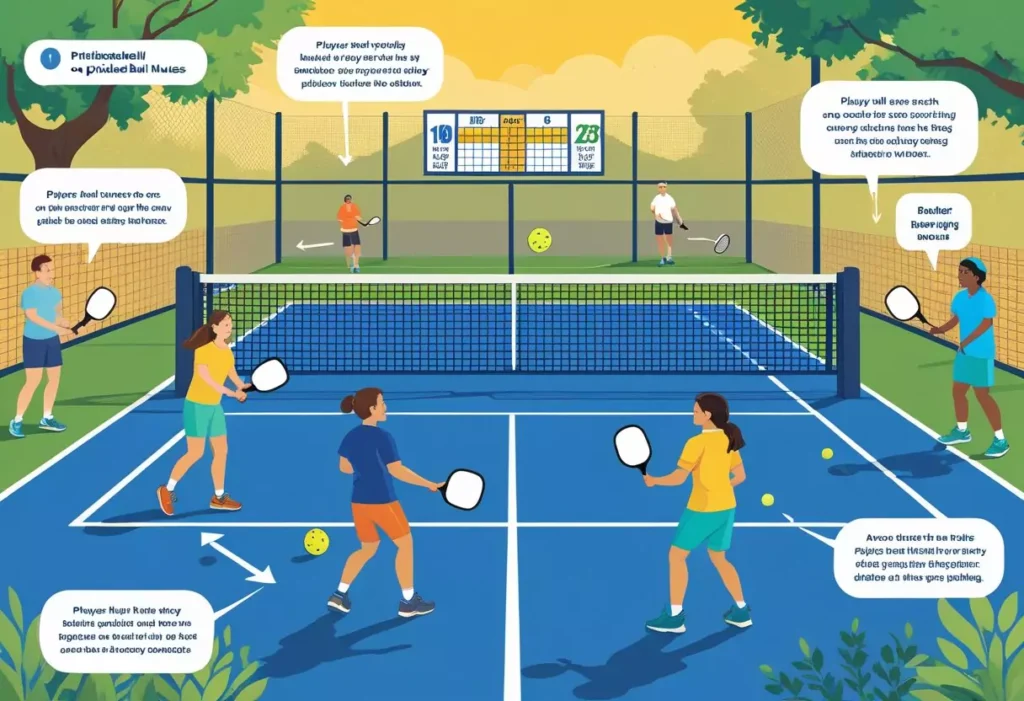
Pickleball is played on a 20-foot by 44-foot court, with a net height of 36 inches at the sides and 34 inches in the middle. The non-volley zone, also called the kitchen, extends 7 feet from the net on both sides and restricts players from volleying while standing inside.
The game starts with an underhand serve made diagonally from behind the baseline. Players must serve with the paddle below the wrist and keep one foot behind the line. The ball must clear the kitchen and land in the opponent’s service area.
The two-bounce rule is important: after the serve, the ball must bounce once on each side before players can hit volleys. This rule helps keep play fair and allows players time to position themselves.
Only the serving team can score points. Games are usually played to 11 points, with a player or team needing to win by 2 points.
Players must avoid faults like serving into the net or kitchen, volleying inside the non-volley zone, or hitting the ball out of bounds. Understanding and respecting these rules help maintain smooth gameplay and fair competition.
Equipment must include a USA Pickleball-approved paddle and ball. Proper footwear with good traction improves safety and performance on the court.
Fundamental Pickleball Rules
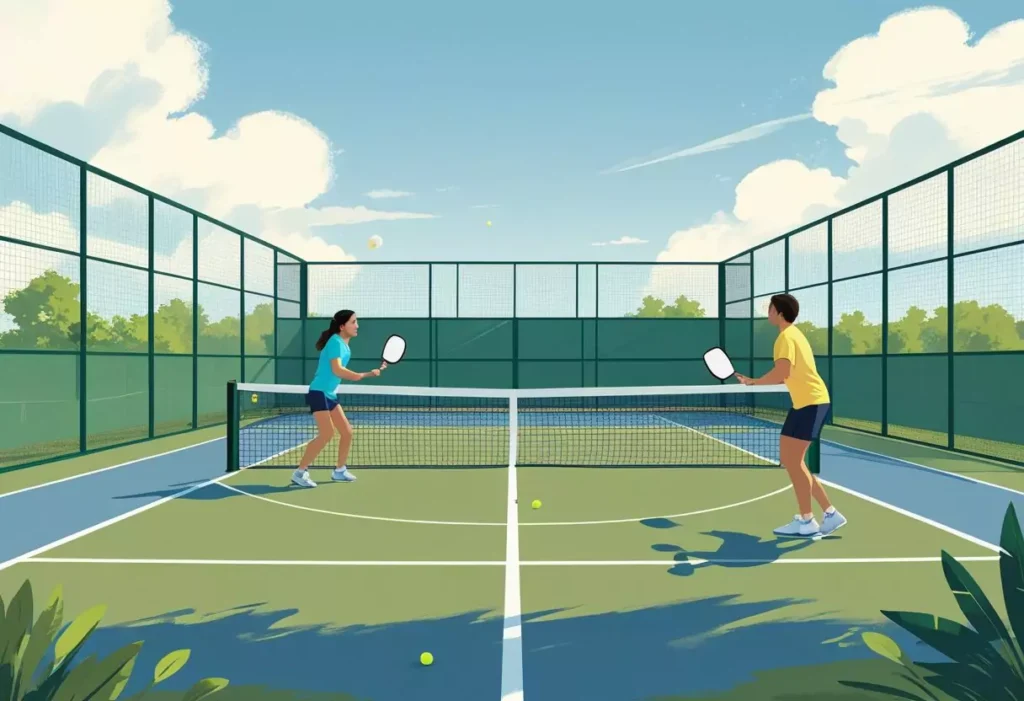
Pickleball is played with clear rules that apply to both singles and doubles formats. The game follows a specific order of play, including how players serve, return, and score points. Understanding these details is essential for playing according to official USA Pickleball rules.
Singles and Doubles Play
Pickleball can be played as singles (one player per side) or doubles (two players per side). The court size and layout remain the same for both formats.
In doubles, each player on the serving team has a chance to serve and score points until a fault occurs. The first serve in doubles starts from the right-hand side. Players switch serving courts after scoring points, alternating between the right and left sides.
In singles, the server serves from the right side when their score is even and from the left side when their score is odd. Unlike doubles, only the server serves until a fault. Both formats use the same court dimensions and follow the same basic gameplay rules.
Basic Gameplay Sequence
The serve in pickleball must be made underhand, with the ball struck below the waist. Serves must be diagonal to the opponent’s court and land within the boundaries.
After the serve, the receiving team must let the ball bounce once before returning it. The serving team also must let the ball bounce once before playing it. This is known as the “two-bounce rule” and extends rallies.
Once both bounces have occurred, players may volley or play the ball after a bounce. Faults, such as hitting the ball out of bounds or volleying inside the non-volley zone, result in losing the point or serve. Points are scored only by the serving team using traditional side-out scoring, usually to 11 points with a win-by-2 rule.
Pickleball Court and Equipment
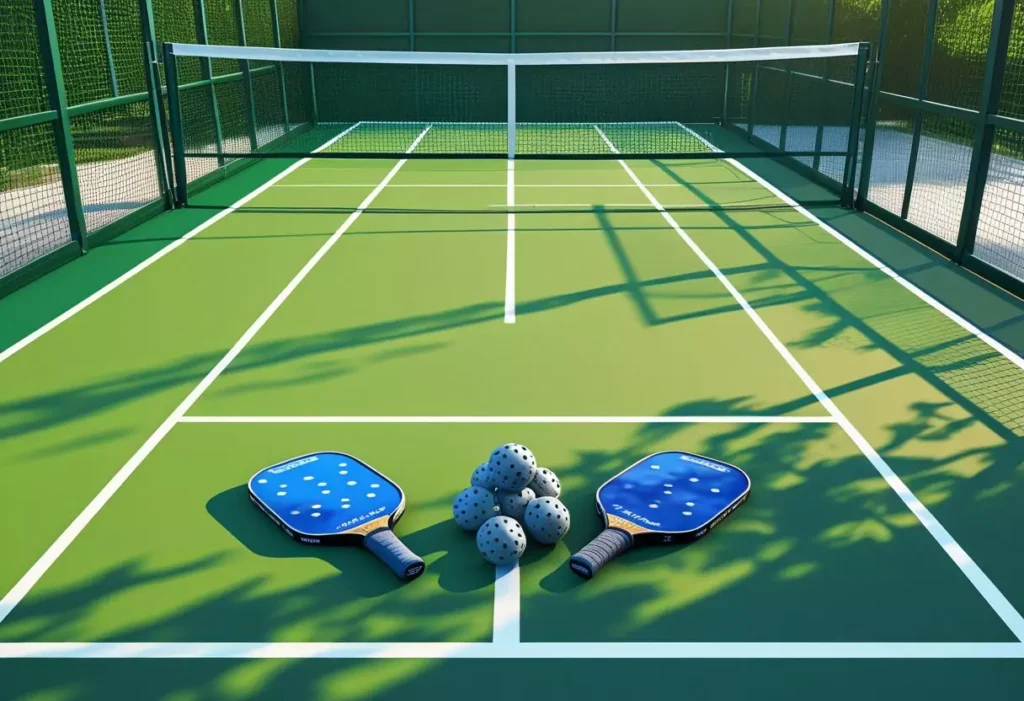
The pickleball court has specific measurements and features that support fair play. The equipment, including paddles and balls, must meet set standards to ensure consistent performance. These details align with rules established by USA Pickleball.
Court Dimensions and Layout
A pickleball court measures 20 feet wide and 44 feet long. This size is the same for both singles and doubles matches. The court is divided into two halves by a net.
Each side has a non-volley zone called the “kitchen,” which stretches 7 feet from the net. This area prevents players from hitting the ball while standing too close to the net. The rest of the court is divided into service areas and baselines.
Boundary lines mark the court edges. All lines are 2 inches wide and count as in-bounds when the ball lands on them. The court surface can be made of materials like wood, concrete, or asphalt, but it must be flat and level.
Net Specifications
The net is 36 inches tall at the sidelines and 34 inches tall at the center, creating a slight dip in the middle. This height supports the minimum clearance needed for gameplay.
The net stretches across the full width of the court, exactly 20 feet wide. It must be secured tightly so it doesn’t sag below the required height during play. The posts supporting the net are placed outside the sidelines to avoid interference.
A tape or band at the top edge of the net helps keep the height consistent. Proper net tension and height are crucial for fair serves and rallies.
Approved Paddles
Pickleball paddles are solid and flat with no strings. They are typically made of composite materials, wood, or graphite. USA Pickleball approves paddle sizes and weights to keep play balanced.
Paddle lengths usually range between 15 to 17 inches, but the width must not be more than 8 inches. Thickness varies but generally falls between 0.5 and 1.0 inch. Players must use paddles without holes or holes that meet regulations.
Weight affects control and power. Lighter paddles are easier to maneuver, while heavier ones offer more hitting power. However, all paddles must comply with size and weight rules to be allowed in official games.
Ball Requirements
Pickleball balls are made of durable plastic and have holes to reduce speed and wind effect. USA Pickleball approves balls based on size, weight, and hole count.
The ball diameter must be between 2.87 and 2.97 inches. Weight ranges from 0.78 to 0.935 ounces. The number of holes usually ranges from 26 to 40, arranged evenly around the ball.
Balls are designed for indoor and outdoor play, with indoor balls generally being lighter and softer. Outdoor balls are harder and heavier to withstand weather and rough surfaces. Proper ball choice affects gameplay speed and control.
Serving Rules in Pickleball
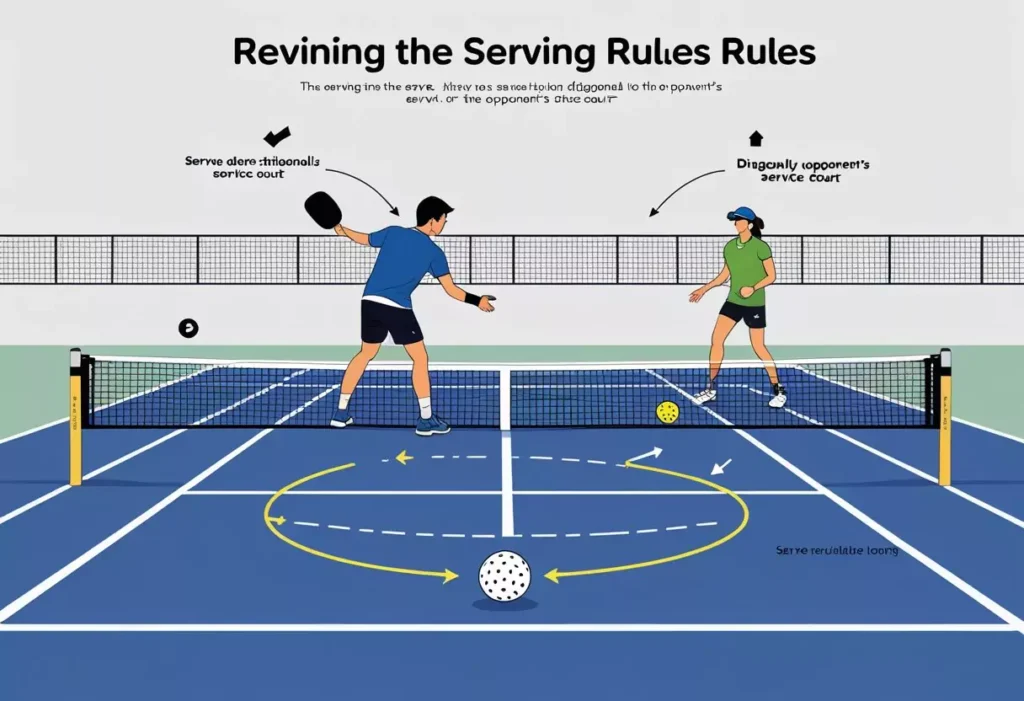
Serving in pickleball requires precise actions to be legal and avoid faults. The player must follow specific techniques, maintain position correctly, and understand allowed serve types. These rules combine to keep the game fair and consistent.
Legal Serve Techniques
The serve in pickleball must be made underhand with the paddle contacting the ball below the wrist level. The paddle should move in an upward arc, not sideways or above the waist. Only one serve attempt is allowed; a fault ends the service.
Players cannot add spin to the ball during the serve in official USA Pickleball tournaments since 2023. Tossing or dropping the ball must be done without causing spin. The serve must land diagonally in the opponent’s service court.
The goal is to start the rally fairly while giving the server a chance to control the play. Illegal serves often result from paddle height, spin, or motion mistakes.
Drop Serve Rules
The drop serve allows the player to drop the ball without throwing or spinning it. The ball must be hit after it bounces on the court, with no restrictions on the number of bounces before contact.
Unlike the traditional serve, the drop serve does not require the paddle to contact the ball in an upward arc or below the wrist strictly, simplifying legal serve execution. The ball must be dropped naturally, not from elevated positions or aids.
This serve type eliminates many serve faults and is now a permanent option under USA Pickleball rules. It offers players more consistency and variety without risking illegal serve calls.
Server Positioning and Foot Placement
During the serve, the server must keep at least one foot behind the baseline. Neither foot can touch the baseline or court until after the ball is struck, strictly enforced to prevent foot faults.
The server must serve diagonally to the opponent’s service box on the opposite side of the court. In doubles, each server continues serving from alternating sides until a fault occurs.
The server’s feet and body must stay within the imaginary sidelines and behind the baseline. Violating these positioning rules results in a serve fault. Precise foot placement supports legal and effective serving.
Service Sequence and Rotation
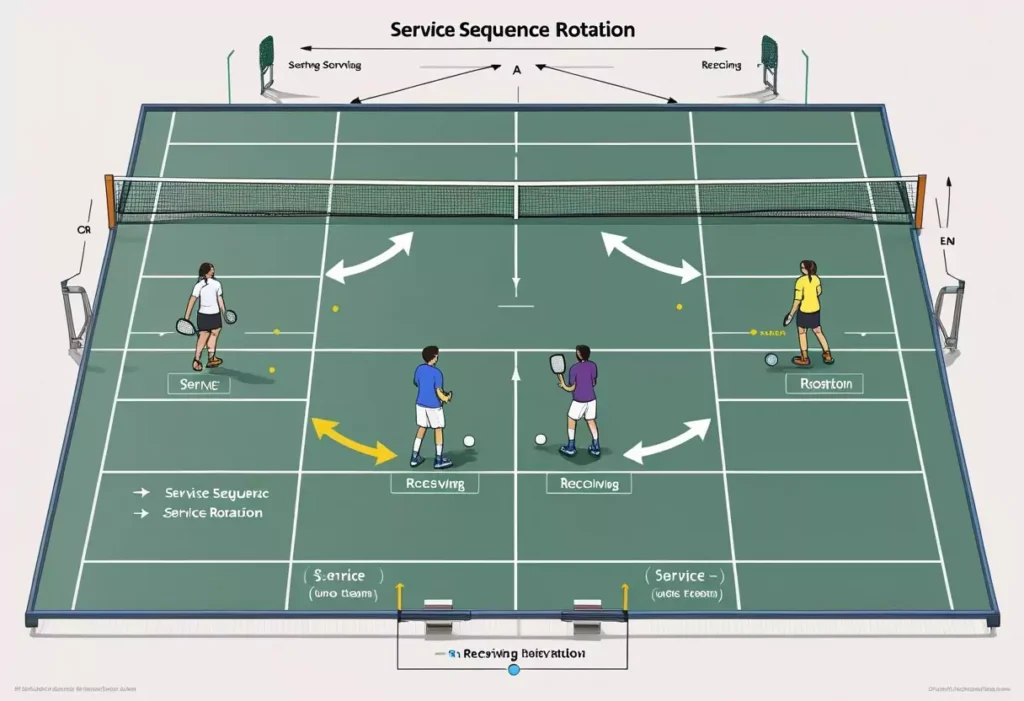
The service sequence in pickleball follows specific rules for singles and doubles play. It controls who serves, where they serve from, and how serving alternates after points and faults. Knowing these details helps maintain fair play and proper scoring.
Doubles Service Rotation
In doubles, the first server begins serving from the right (even) side when their team’s score is even and from the left (odd) side when the score is odd.
Both players on a team serve before the serve shifts to the opponents. The first server serves until the team loses a rally or commits a fault, then the second server serves from their correct side following the same right-left rotation after each point won.
Only after both servers lose their serve does the serve go to the other team. Players can position anywhere on their side of the court before the serve, except for the server who must follow serving rules strictly.
Singles Service Sequence
In singles, the server always serves from the right side when their score is even (0, 2, 4, etc.) and from the left side when the score is odd (1, 3, 5, etc.).
The serve must be directed diagonally to the opponent’s court. The server continues serving, alternating sides after each point won.
If the server loses the rally or commits a fault, the serve passes to the opponent. The sequence repeats with each player serving from the right or left depending on their current score.
This method keeps the flow consistent and fair in singles matches according to USA Pickleball rules.
Pickleball Scoring Systems
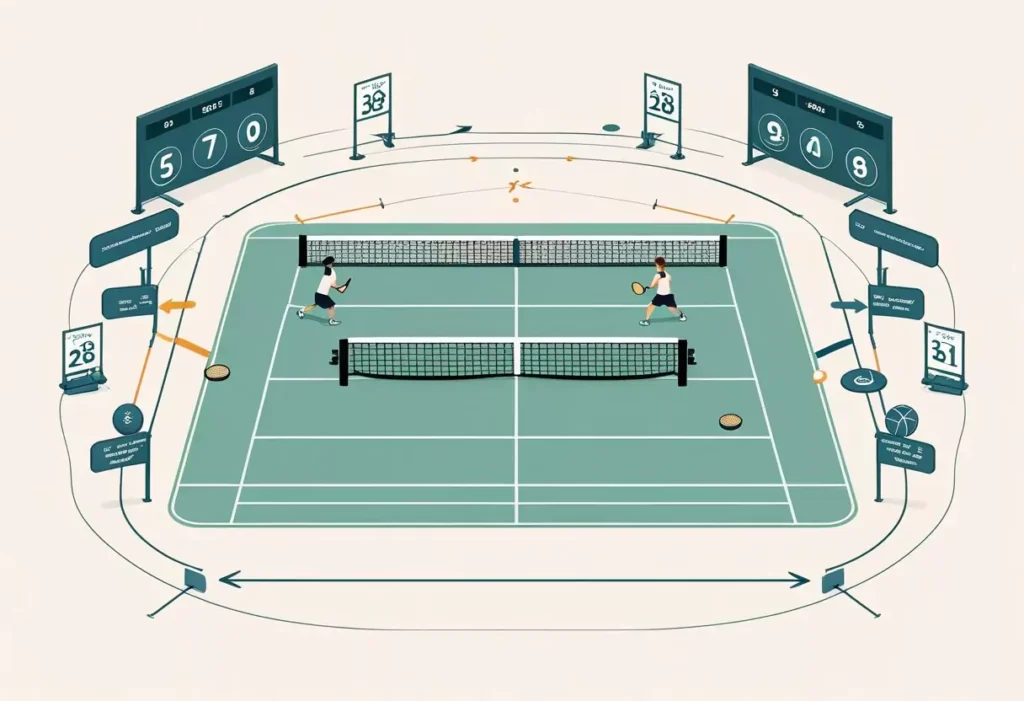
Pickleball uses two main scoring systems: traditional side-out scoring and rally scoring. Both systems have distinct rules for how points are earned and how the serve changes. The game-winning rules also vary by format but always require at least a two-point lead.
Traditional Side-Out Scoring
In traditional side-out scoring, points can only be scored by the serving team. If the serving team wins the rally, they earn a point and continue serving. If they lose the rally, the serve passes to the other team without awarding a point. This system applies to both singles and doubles matches.
In doubles, the serving team has two chances to serve before the serve goes to the opponents, except the first service turn of the game where only one server serves to balance the advantage of starting first. Players serve from the right side of the court when their score is even and from the left when odd. The score is called as server score, receiver score, and in doubles, the server number (1 or 2).
Rally Scoring Formats
Rally scoring awards a point to the winner of every rally, regardless of which team served. This format speeds up the game and keeps the score moving steadily. It is an optional scoring method recognized by USA Pickleball since 2025, especially for certain tournaments like round-robin and team play.
In rally scoring singles and doubles, players serve from sides based on the even or odd nature of their score, similar to traditional scoring. In doubles, there is no second server, and players must switch sides after every point scored by the serving team. The serve passes immediately after any lost rally, and points are awarded continuously.
Typical Game Winning Conditions
Games are usually played to a set point total, such as 11, 15, or 21 points depending on the level or tournament. However, a player or team must win by at least two points, so the game can extend beyond the target score.
In both scoring systems, the winning team must score the final point while serving. If the receiving team reaches game point and wins a rally, it results in a side-out rather than a win. This rule emphasizes the importance of serving at game point, regardless of whether side-out or rally scoring is used.
The Two Bounce Rule Explained
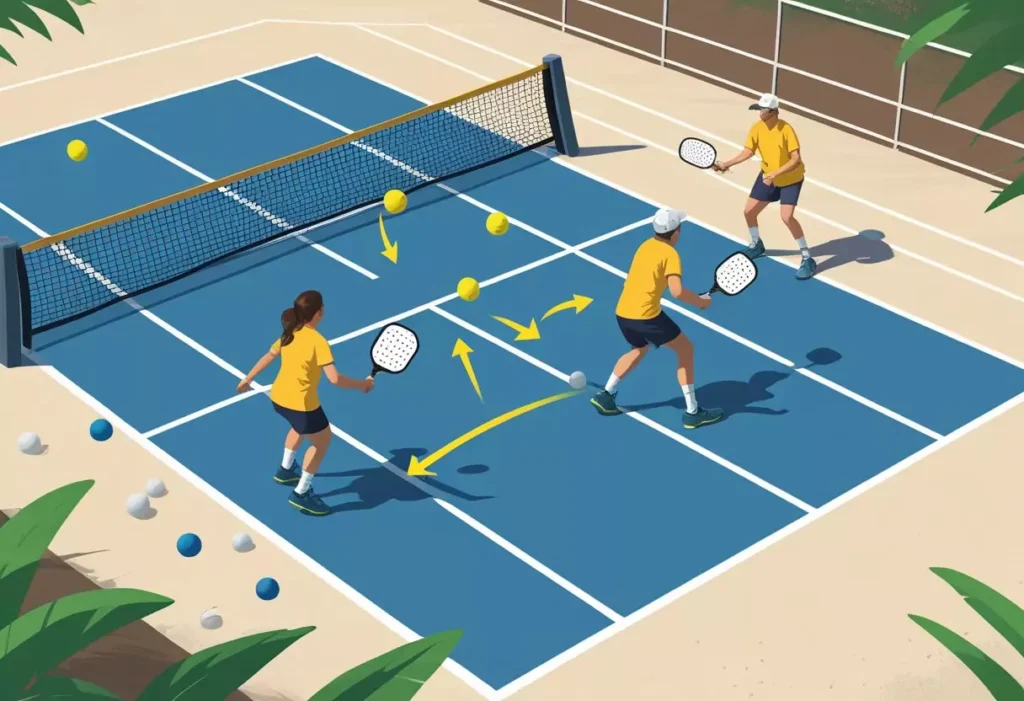
The two bounce rule is a key rule in pickleball that affects how the game starts. It requires the ball to bounce once on each side of the net before players can hit it in the air, called volleying.
First, the serving team must hit the ball so it bounces on the opponent’s court. This is the first bounce. Then the receiving team must return the ball and let it bounce on the server’s side. This is the second bounce.
Only after these two bounces happen can either team volley the ball. This means players cannot smash or hit the ball out of the air on the very first or second shot. Doing so is a fault.
Here is a simple breakdown:
| Step | What Happens |
|---|---|
| 1st bounce | Ball bounces on receiver’s side |
| 2nd bounce | Ball bounces back on server’s side |
| After 2 bounces | Players may volley or hit ground shots |
The rule helps keep the game fair by slowing down the pace early. It prevents the serving team from attacking the net right away with a volley. This gives both teams a chance to position themselves and plan their next moves.
The two bounce rule is easy to learn but often forgotten by new players. It shapes pickleball’s unique style and strategy.
Understanding the Non-Volley Zone
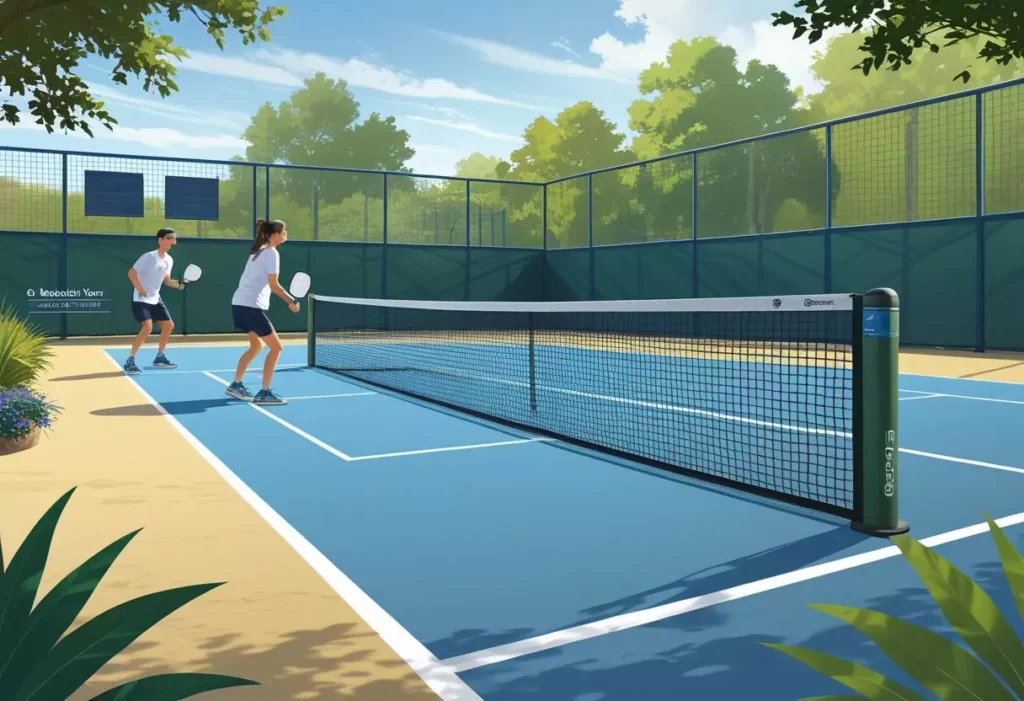
The non-volley zone in pickleball limits where players can hit the ball without it bouncing first. The rules govern the zone’s size, where players may move, and what actions cause faults. These rules help keep play fair and strategic.
Non-Volley Zone Boundaries
The non-volley zone, often referred to as “the kitchen,” is a 7-foot area that extends from the net toward each side of the court. It runs the full width of the court.
The kitchen’s line denotes the boundary. Players must keep their feet completely outside this zone when volleying—that means hitting the ball before it bounces. Stepping on or inside the line during a volley is not allowed.
For wheelchair players, the smaller front wheels may touch the kitchen during a volley, but the rest of the wheelchair must stay outside. This rule helps accommodate all players fairly.
Actions Allowed in the Kitchen
Players may enter the kitchen anytime during the game, except when volleying. It is allowed to step inside the zone to hit a ball after it bounces.
Players can stay inside the kitchen to rally on balls that bounce. They do not have to step out immediately after hitting a ball inside the zone.
It’s legal for a partner to stand in the kitchen while the other volley’s as long as they do not touch each other or enter the kitchen during the volley.
Faults Involving the Kitchen
It is a fault if a player volleys the ball while any part of their body or clothing is touching the kitchen, including its line.
A fault also occurs if momentum from a volley causes the player to contact the kitchen or anything in it, like their partner. This applies even if the ball was already dead.
If a player’s feet or wheelchair touch the kitchen after volleying, they must wait to volley again until fully outside the zone. Jumping from inside the kitchen to volley outside is a fault.
These faults maintain fairness and emphasize the strategic role of the non-volley zone in pickleball.
Line Call Rule and Ball In/Out
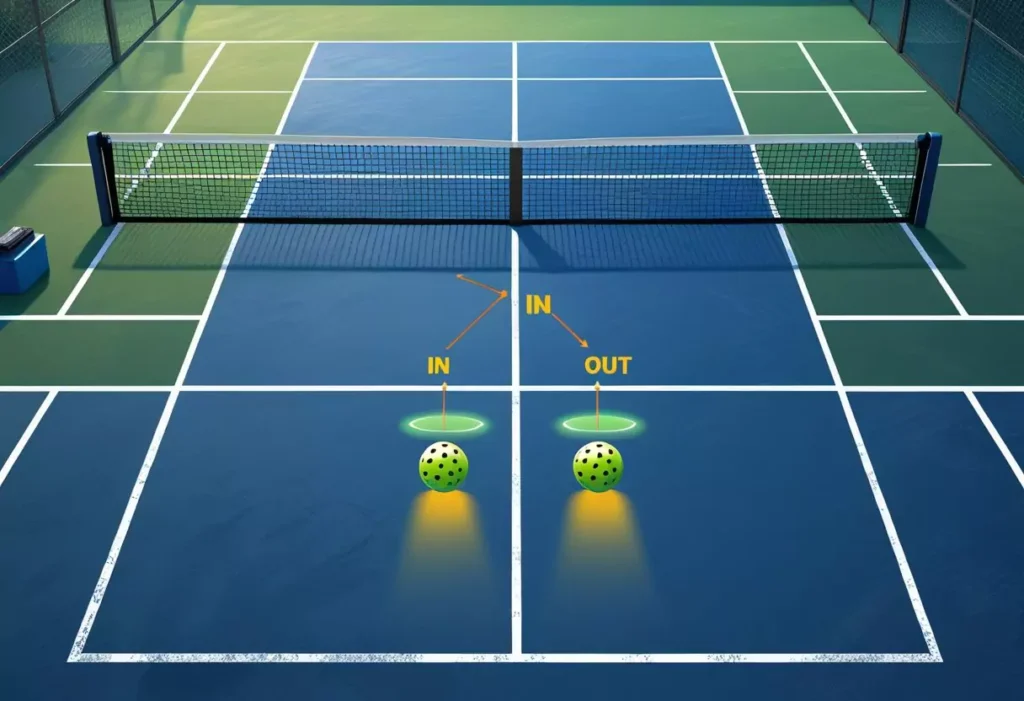
In pickleball, knowing when the ball is in or out is crucial. Players must make clear calls on their side of the court. Specific rules guide how to judge these calls, and the serve has its own unique line requirements.
Calling Lines Correctly
Players are responsible for calling lines on their side of the court. Any ball that lands on a line, or touches it, is considered in. If a player cannot clearly see the ball or is unsure, the ball defaults to in.
Calls must be honest and firm because players cannot ask for a replay if they miss the call or are uncertain. In doubles, if one partner calls a ball out and the other calls it in, the ball is ruled in.
Spectators are not allowed to influence or make line calls. In tournaments, if a player can’t see where the ball landed, they may ask the referee for help. If the referee cannot decide, the ball is ruled in.
Serve Line Rules
The serve has special line call rules. The ball must clear the non-volley zone, also called the kitchen, and must not land inside it. The serve must land crosscourt, meaning diagonally across the court, within the area between the baseline, sideline, and centerline.
If the ball touches or lands on the kitchen line during a serve, it is out. The serve must land past the kitchen line but still inside the proper boundaries to be valid.
In summary, the serve requires strict attention to the ball’s position relative to the kitchen and specific court lines to be legal.
Common Faults and Rule Violations
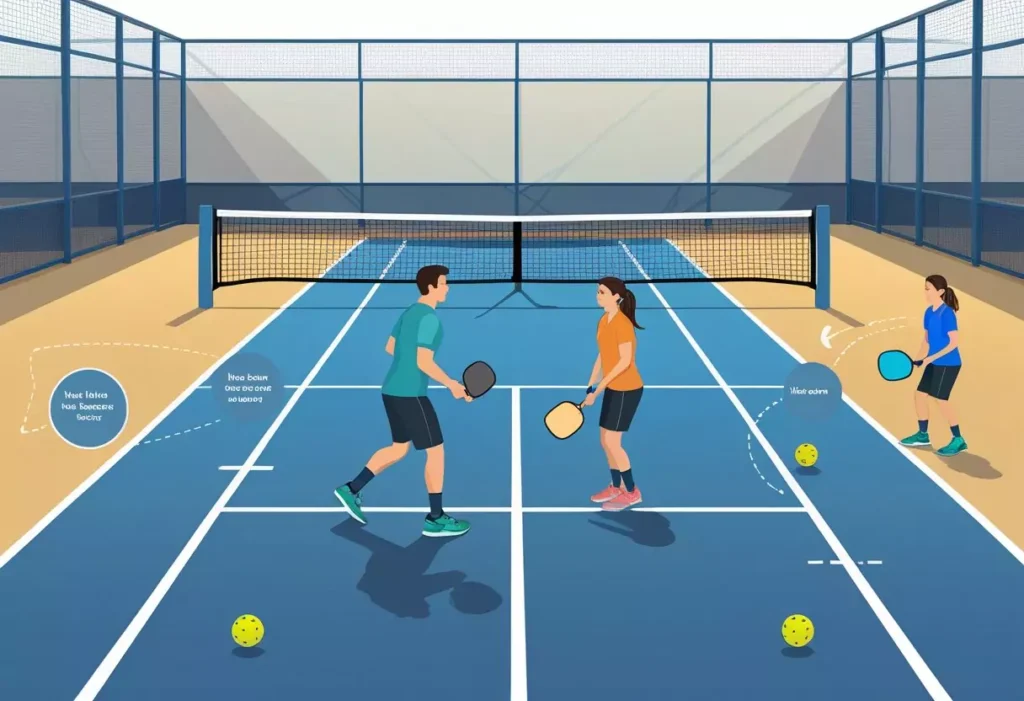
Faults in pickleball are specific rule violations that stop play immediately. They are important because they directly affect who earns points or loses the serve. Understanding these faults helps players follow the rules and avoid handing advantages to opponents.
Types of Faults
There are several types of faults defined in pickleball rules. Serving faults include serving outside the correct area or not keeping one foot behind the baseline during the serve. If a serve lands in the kitchen (non-volley zone) or fails to cross into the opponent’s court, it is a fault.
In-play faults happen when the ball is hit out of bounds, bounces twice before being returned, or is volleyed from the kitchen zone. Other examples include hitting the net, touching the opponent’s court during play, or double-hitting the ball.
Players also commit faults by stepping into the kitchen zone while volleying or by carrying the ball on their paddle. Using more than one paddle in a rally or distracting opponents during their shot are considered faults as well.
How Faults Affect Play
Faults in pickleball cause the rally to end immediately. When the serving team faults, they lose the serve, known as a “side out.” This passes the serve to the other team.
If the receiving team faults, the serving team scores a point and continues serving. This scoring method makes faults crucial in deciding who controls the pace and momentum.
Players must be aware of position rules, as serving from the wrong side also results in faults. Faults keep the game fair and ensure players follow the established pickleball rules to maintain orderly play.
Dead Ball and Let Rules
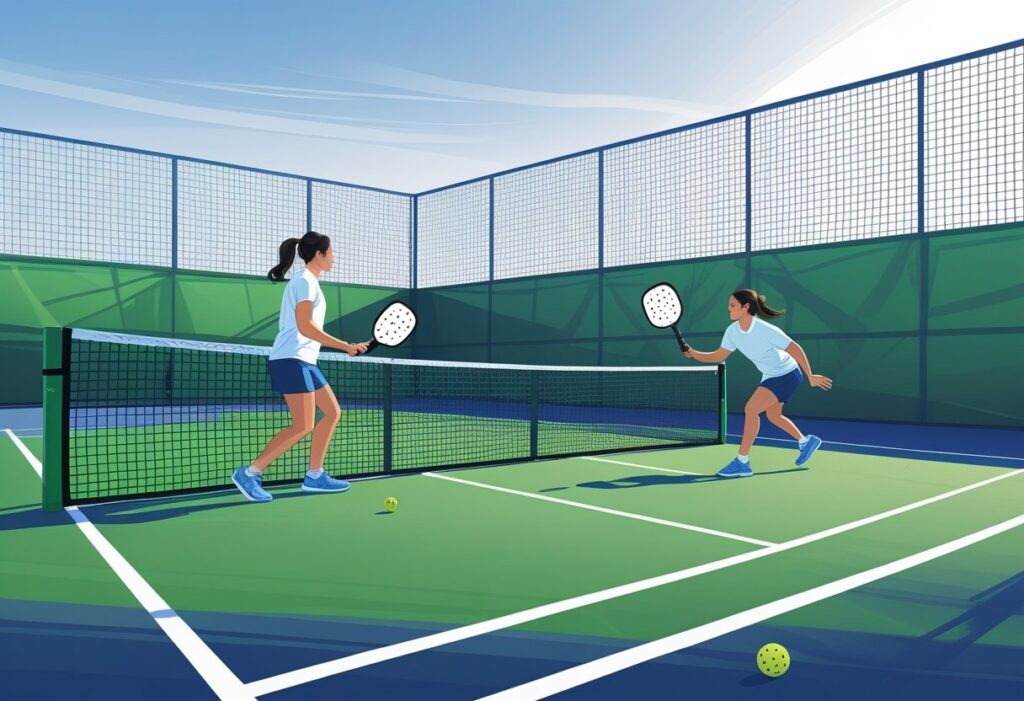
In pickleball, play can stop for various reasons, and knowing when the ball is dead is important. The rules also clarify when a serve is replayed due to specific situations. These rules help keep the game fair and consistent.
Dead Ball Situations
A dead ball happens whenever play stops. This can occur if a fault is called by a player or referee. Faults include hitting the ball out of bounds, double bouncing, or stepping into the non-volley zone illegally.
Other causes for a dead ball include any action that interrupts the game. For example, if the ball hits a permanent object after bouncing in the opponent’s court, the ball is dead, and the last hitter wins the rally.
If a player calls a hinder—something that blocks play—the referee or players decide if the hinder is valid. When it is, the point is replayed. Dead balls ensure the game pauses only when necessary under USA Pickleball’s official rules.
Let Serve Clarifications
The 2025 USA Pickleball rule changes removed the let serve. Previously, if the serve touched the net and landed in the correct service court, the serve was replayed.
Now, if the serve hits the net but still lands in the service area, the serve counts as valid, and play continues. If the serve misses the service box or hits the net and lands outside, it is a fault.
This change speeds up the game by reducing interruptions during serving. Players no longer wait for a re-serve on these net contacts, which keeps play smoother and more continuous.
Tournament and Advanced Regulations
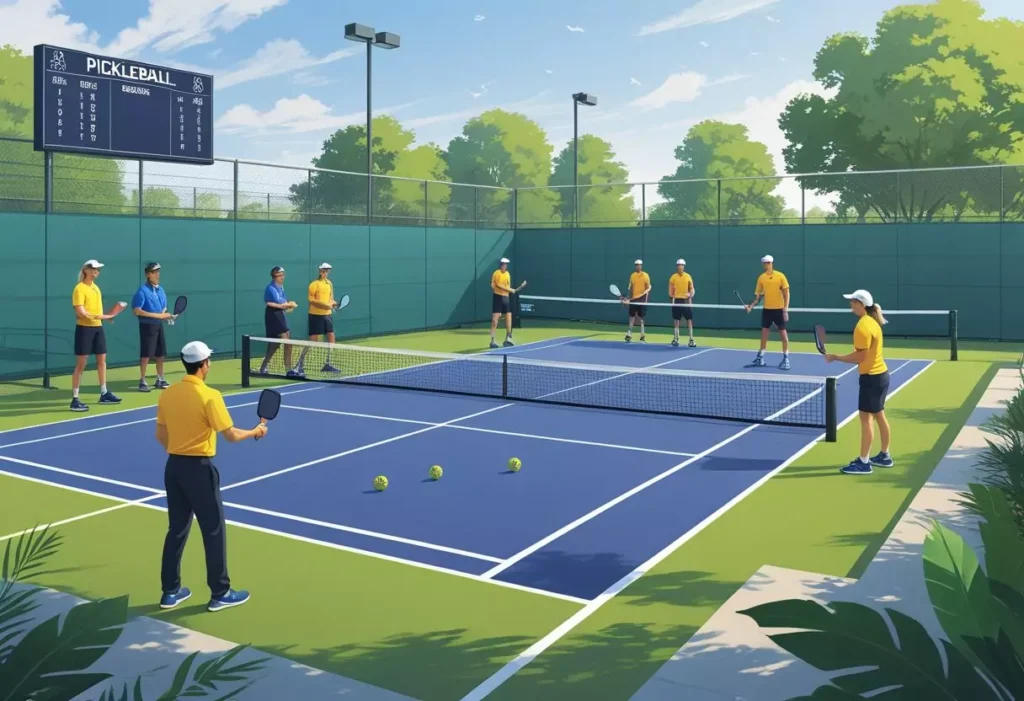
Tournament play in pickleball follows strict rules to ensure fairness and consistency. Players must understand the official regulations, how sanctioned events differ, and the roles of officials during matches.
Official USA Pickleball Rules
USA Pickleball sets the standard rules for all levels of play, including tournaments. These rules cover court dimensions, scoring, serving, faults, and player conduct. Every player must follow them to maintain fair competition.
A key rule requires teams to visibly identify their starting server in each game. Refusing to wear the identification leads to a match forfeit. Also, players call faults on themselves, promoting sportsmanship.
USA Pickleball updates its rulebook regularly to address new situations and maintain clarity. Players and officials must stay current with the latest guidelines.
Sanctioned Tournament Differences
Sanctioned tournaments follow USA Pickleball rules but add extra layers of structure. These tournaments allow players to earn official ratings nationally or internationally.
Tournament Directors have wide authority, including making final decisions on disputes, expelling players for misconduct, and approving waived rules for court limitations.
Pre-tournament briefings inform players of court specifics and any local conditions that may affect play. Exceptions to standard rules require prior approval from USA Pickleball officials.
Officiating and Scorekeeping
Referees enforce rules and make judgment calls during matches. They handle line calls, faults, score announcements, and player conduct warnings.
Players remain responsible for calling faults on their side but may appeal referee decisions to the Tournament Director. Line judges may assist, but referees have final authority.
Technical fouls can lead to point adjustments or forfeits. Referees communicate clearly about warnings and maintain order to keep matches running smoothly and fairly.
Final thoughts
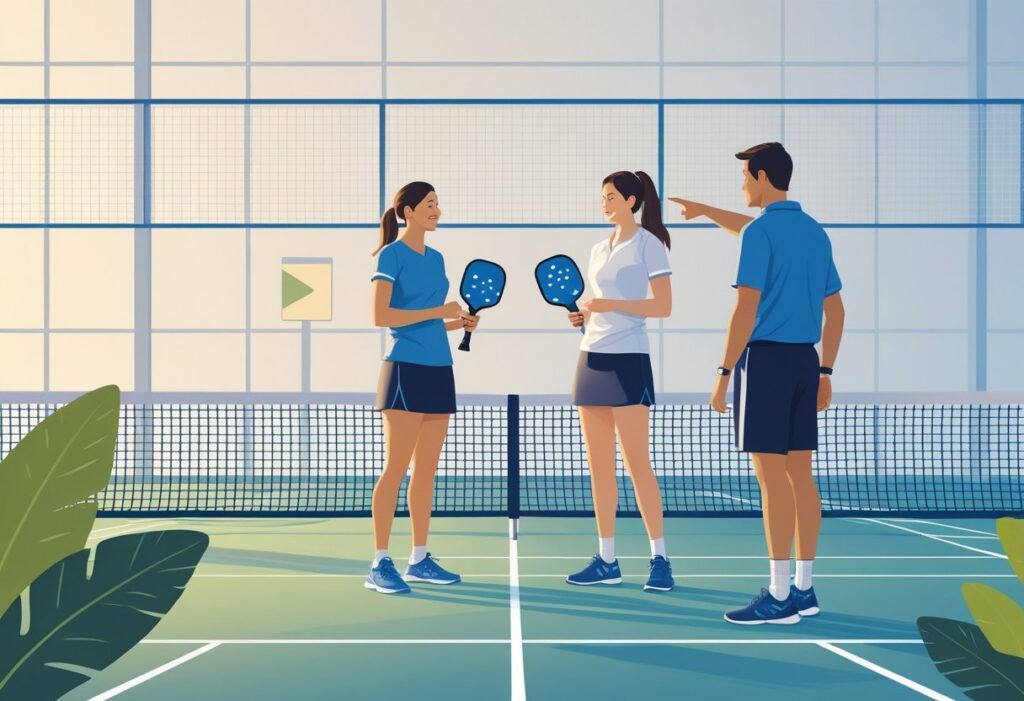
The 2025 pickleball rule changes reflect the sport’s ongoing effort to improve fairness and playability. These updates will impact how players communicate, call faults, and serve. Understanding them helps players avoid confusion and keep games running smoothly.
Teamwork plays a bigger role now. For example, players must agree on foot faults before calling one, encouraging better communication.
Honesty and sportsmanship are also emphasized. Players are expected to call faults on their partners promptly, which supports integrity during matches.
Several rules focus on safety and fairness, such as allowing verbal “not ready” signals and restricting spectator input on line calls. These changes help protect players and keep the focus on fair decisions.
New serving options and changes to rally scoring aim to speed up games and introduce fresh strategies. Players will need to adjust and practice these skills to stay competitive.
To prepare, players should:
- Read the updated rulebook thoroughly
- Practice new techniques with others
- Stay informed about any additional clarifications
By embracing the 2025 rules, players can expect a game that remains fair and engaging for all levels. The changes support better gameplay while preserving the spirit of pickleball as a fast, friendly, and inclusive sport.
Comperion table
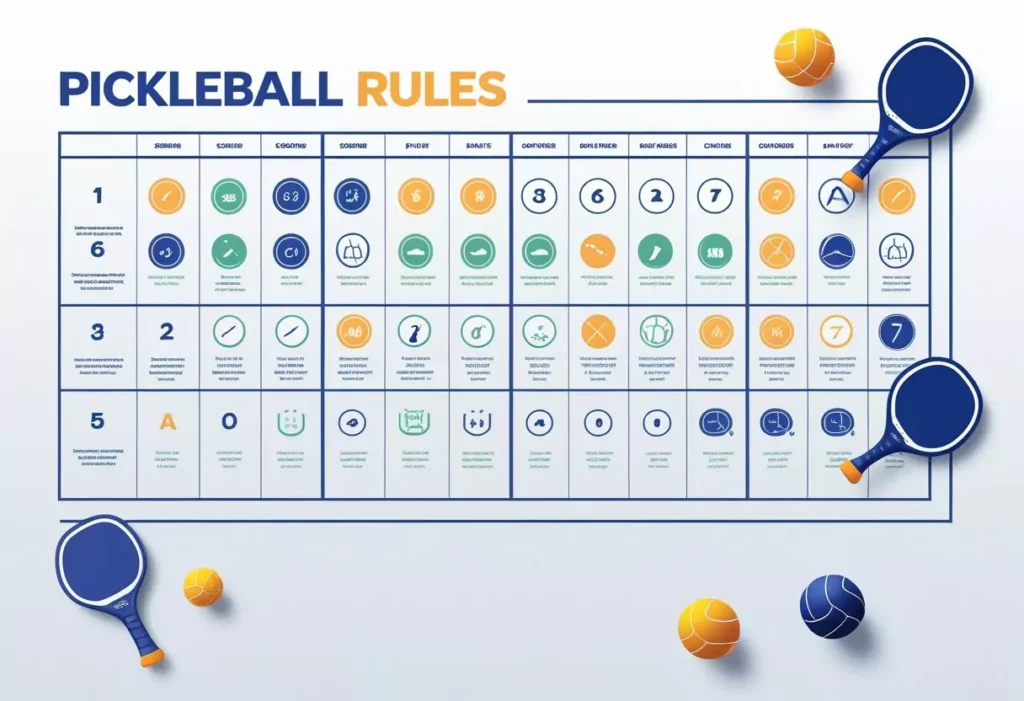
The table below compares key rules and features of pickleball with table tennis to highlight their differences and similarities. Both sports involve paddles and a ball but vary in court size, scoring, and play style.
| Feature | Pickleball | Table Tennis |
|---|---|---|
| Court Size | 20 ft by 44 ft | Approx. 9 ft by 5 ft |
| Equipment | Paddle, plastic ball | Small paddle, lightweight ball |
| Serve | Underhand, diagonal to opposite court | Overhand or underhand, anywhere on opponent’s side |
| Scoring | Points only when serving, usually to 11 win by 2; some use rally scoring | Points on every rally, often to 11 or 21 |
| Gameplay | Includes non-volley zone (“kitchen”); allows volleys after two bounces | Fast reflexes and quick rallies, no bounce rules |
| Players | Singles or doubles | Singles or doubles |
Pickleball uses a larger court and slower ball, allowing longer rallies. The “two bounce rule” requires the first shot from each side to bounce. Table tennis focuses on fast reflexes and quick exchanges with a smaller playing area.
The serve in pickleball must meet strict rules about paddle position and foot placement. Table tennis serves are more varied with less positional restriction. These rules shape the different pace and tactics for each sport.
Frequently Asked Questions
This section explains important rules on serving, scoring, court layout, and gameplay specifics. It covers how players must serve, how points are counted, and differences between singles and doubles. It clarifies the two-bounce rule and details the non-volley zone, often called the kitchen.
What are the basic rules of serving in pickleball?
The server must hit the ball with an upward motion below the waist. The paddle cannot be above the wrist at the moment of contact.
The serve must be made diagonally across to the opponent’s court and land inside the boundaries. Only one serve attempt is allowed per turn except in specific fault conditions.
At least one foot must stay behind the baseline while serving. Feet cannot touch the court lines or outside the sideline and centerline extensions during the serve.
How does scoring work in a pickleball game?
Points are usually scored only by the serving team. Games normally go to 11 points, but winning requires a 2-point lead.
In some formats, rally scoring is used where a point is awarded after every rally regardless of who serves.
Can you explain the two-bounce rule in pickleball?
After the serve, the receiving team must let the ball bounce once before returning it. Then, the serving team must also let it bounce once before playing the ball.
After these two bounces, either team can volley or hit the ball in the air.
What is the ‘kitchen’ in pickleball and what rules apply to it?
The kitchen is the non-volley zone, a 7-foot area on each side of the net.
Players cannot volley the ball while standing inside or touching this zone. If a player steps into or touches the kitchen when volleying, it is a fault.
Players may enter the kitchen to hit a ball that bounces there.
What are the key differences between singles and doubles play in pickleball?
The court size and markings are the same for both singles and doubles.
In doubles, both players on the serving team have chance to serve and score until a fault, except at the start of a game. In singles, serving side switches based on the server’s score being even or odd.
What are the official dimensions and markings of a pickleball court?
A pickleball court is 20 feet wide and 44 feet long for both singles and doubles.
The court includes a 7-foot non-volley zone on each side of the net, sidelines, baselines, and a centerline dividing the service courts. All lines are considered in bounds except when the serve lands in the non-volley zone line, which is a fault.
